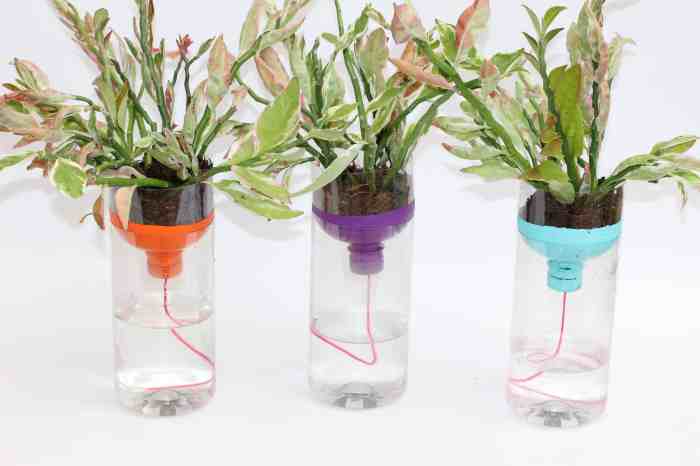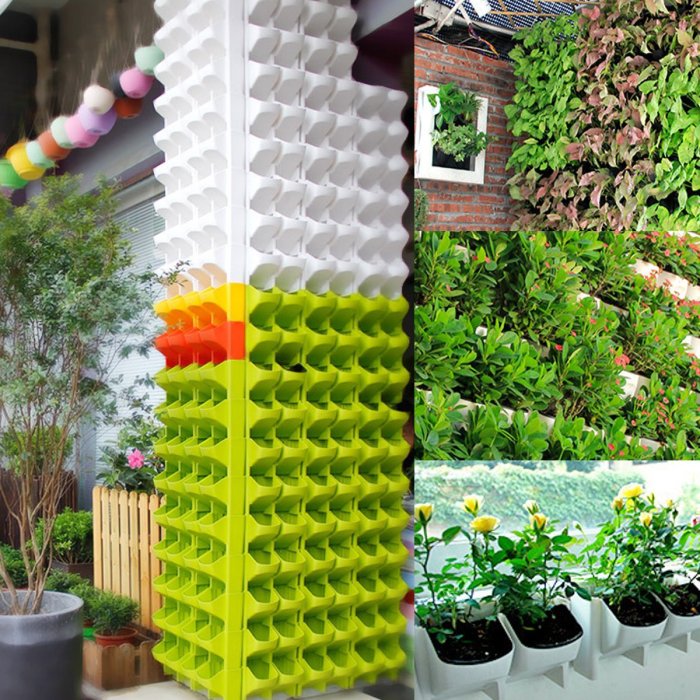Introducing indoor wall planters self watering, the innovative solution for creating vibrant vertical gardens within your home. These self-sufficient planters revolutionize indoor gardening, offering a hassle-free way to cultivate lush greenery with minimal effort.
From exploring the various self-watering mechanisms to selecting the perfect plants and mastering wall mounting techniques, this comprehensive guide empowers you to transform your walls into thriving ecosystems.
Self-Watering Mechanisms

Indoor wall planters with self-watering systems are becoming increasingly popular due to their convenience and ability to provide optimal hydration for plants. These systems use various mechanisms to deliver water to the plant’s roots, allowing for extended periods between watering.
Wick Systems
Wick systems utilize a capillary action to draw water from a reservoir to the plant’s roots. A wick, typically made of cotton or nylon, is inserted into the reservoir and runs through the soil, providing a continuous supply of moisture.
Wick systems are simple to set up and maintain, but they may not be suitable for plants with high water requirements or in environments with low humidity.
Reservoir Systems
Reservoir systems consist of a water reservoir attached to the planter. Water is released from the reservoir through a small opening or tube, directly into the soil. Reservoir systems provide a more consistent water supply than wick systems, but they require more frequent monitoring and refilling of the reservoir.
Sub-Irrigation Systems
Sub-irrigation systems use a water-filled tray or capillary mat placed below the planter. Water is drawn up through the soil by capillary action, providing moisture to the plant’s roots. Sub-irrigation systems are less visible than other self-watering mechanisms and can be ideal for plants that prefer moist soil conditions.
Gravity-Fed Systems
Gravity-fed systems rely on the force of gravity to deliver water to the plant’s roots. Water is stored in a reservoir located above the planter and released through a tube or valve. Gravity-fed systems provide a continuous water supply but require a higher elevation of the reservoir than the planter.
Plant Selection for Self-Watering Planters

Choosing the right plants for self-watering wall planters is crucial for their success. Factors to consider include water requirements, growth habits, and root systems.
Suitable Plant Species
Ideal plants for these planters have low to moderate water needs, such as:
- Succulents: Echeveria, Sedum, Sempervivum
- Air plants: Tillandsia
- Pothos
- Peace lily
- Snake plant
Water Requirements
Plants with low water needs are preferred, as the self-watering mechanism provides a constant supply of moisture. Avoid plants that require frequent watering or have high water demands.
Growth Habits
Consider the growth habits of the plants. Choose species that will not outgrow the planter or become too heavy for the wall. Plants with compact or trailing growth habits are suitable.
Root Systems
The root system of the plant should be well-suited to the planter’s design. Plants with shallow or fibrous root systems are ideal, as they can absorb water and nutrients effectively from the shallow reservoir.
Wall Mounting Options
Mounting self-watering wall planters offers a unique way to enhance vertical spaces while adding greenery to your home. Several mounting options are available, each with its own advantages and considerations.
Hanging Hooks and Brackets
Hanging hooks and brackets provide a simple and versatile method for mounting wall planters. These systems typically involve attaching a hook or bracket to the wall and then suspending the planter from the hook.
- Pros:Easy to install, adjustable, suitable for most wall types.
- Cons:May not be as secure as other mounting options, weight limitations.
Wall-Mounted Shelves
Wall-mounted shelves offer a more stable and customizable mounting solution for wall planters. Shelves can be installed at various heights and angles, allowing for creative arrangements.
- Pros:Supports heavier planters, provides additional storage space, customizable.
- Cons:More complex installation, may require additional hardware.
Magnetic Wall Planters, Indoor wall planters self watering
Magnetic wall planters are a unique and innovative mounting option that utilizes magnets to adhere to magnetic surfaces. This method is particularly suitable for metal walls or surfaces.
- Pros:No drilling required, easy to reposition, ideal for magnetic surfaces.
- Cons:Requires a magnetic surface, may not support heavier planters.
Design Considerations
Creating visually appealing indoor wall planters involves careful consideration of design principles. These principles guide the selection of materials, colors, shapes, and textures to enhance the aesthetic appeal of the planters and complement the surrounding décor.
Color
Color plays a significant role in planter design. Bold and vibrant colors can create a striking focal point, while neutral shades provide a more subtle and versatile backdrop for plants. Consider the overall color scheme of the room and choose colors that harmonize or contrast with the existing décor.
Indoor wall planters with self-watering systems provide a convenient solution for plant enthusiasts. To complement these planters, consider incorporating small trailing indoor plants that cascade gracefully down the sides. These plants add a touch of greenery and create a visually appealing display.
When choosing plants for indoor wall planters, consider their light and water requirements to ensure their health and vitality.
Shape
The shape of the planter can greatly influence its visual impact. Geometric shapes, such as squares, rectangles, and circles, offer a modern and minimalist aesthetic. Organic shapes, such as ovals and freeform designs, add a touch of whimsy and natural charm.
Indoor wall planters with self-watering systems offer a convenient and stylish way to add greenery to your home. Small trailing plants, such as small trailing plants , are ideal for these planters as they cascade down the sides, creating a lush and eye-catching display.
The self-watering feature ensures that your plants receive the right amount of water, making them ideal for busy individuals or those who travel frequently.
Texture
Texture adds depth and interest to wall planters. Smooth and glossy surfaces reflect light, creating a sleek and contemporary look. Rough and textured surfaces, such as those made from natural materials like wood or stone, add a rustic and organic touch.
Examples
Here are a few examples of stylish and functional wall planter designs:
- A geometric planter made of powder-coated metal with a matte black finish, featuring a clean and minimalist design.
- An oval planter made of glazed ceramic in a vibrant emerald green, adding a touch of color and organic form to a neutral-toned room.
- A freeform planter made of reclaimed wood with a natural finish, providing a rustic and earthy element to a modern living space.
DIY Wall Planter Projects: Indoor Wall Planters Self Watering
Embark on a fulfilling DIY project by creating your own self-watering wall planters. These innovative planters not only add a touch of greenery to your indoor space but also provide a convenient and low-maintenance way to nurture plants.
Step-by-Step Guide
- Gather materials:
- Plastic bottles (2-liter size)
- Scissors
- Drill
- Screws
- Rope or twine
- Potting mix
- Plants
- Prepare the bottles:
- Cut the bottom off one of the bottles, creating a reservoir.
- Cut a hole in the side of the other bottle, near the bottom, for water flow.
- Invert the reservoir bottle and insert it into the hole in the second bottle.
- Create the hanger:
- Drill holes in the top of the second bottle.
- Thread the rope or twine through the holes and tie it securely.
- Mount the planter:
- Screw the hanger onto the wall at the desired height.
- Hang the planter on the hanger.
- Fill and plant:
- Fill the reservoir with water.
- Add potting mix to the top bottle and plant your desired plants.
Estimated Cost
The cost of this DIY project is minimal, typically ranging from $5 to $15 depending on the materials used.
Last Recap

Whether you’re a seasoned gardener or a novice seeking to add a touch of nature to your living space, indoor wall planters self watering open up endless possibilities for creating stunning and sustainable indoor gardens.
Quick FAQs
Are self-watering planters suitable for all types of plants?
While self-watering planters offer convenience, they may not be ideal for all plant species. Plants with high water requirements or delicate root systems may not thrive in these planters.
How often do I need to refill the water reservoir?
The frequency of refilling depends on the size of the reservoir, the number of plants, and the ambient temperature. Typically, you can expect to refill every 1-2 weeks.